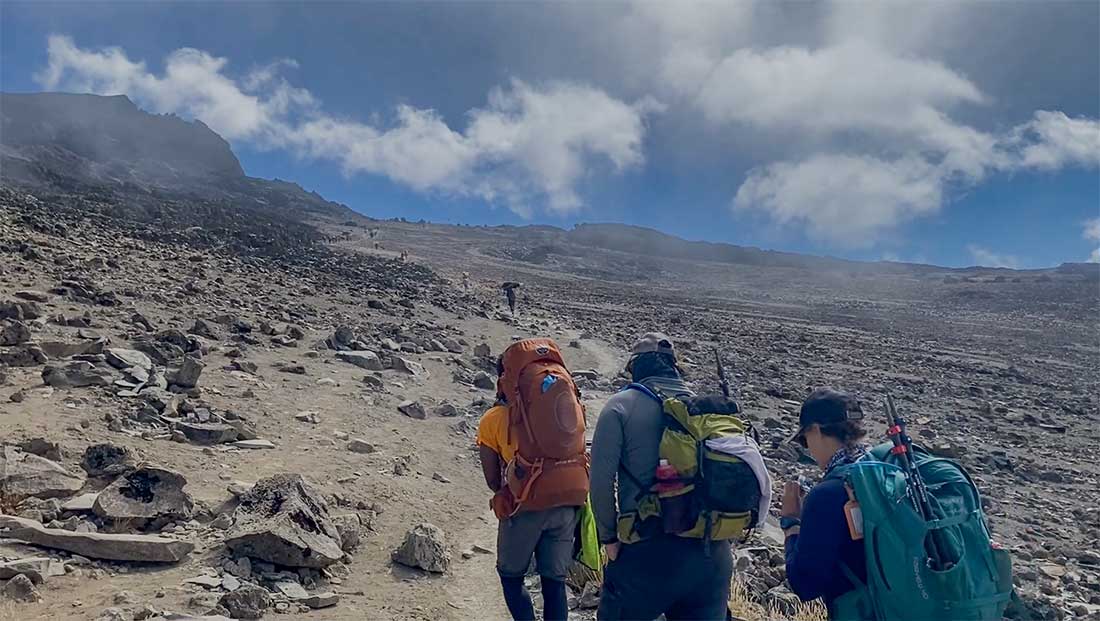Mount Kilimanjaro entices adventurers with its majestic slopes and breathtaking vistas. However, beneath its allure lies a formidable challenge: altitude. As climbers ascend, the risks of altitude sickness heighten. This makes adequate hydration not just a comfort but a vital component of a successful climb. In this article, we delve into the significance of staying hydrated on Kilimanjaro. We also cover how it can spell the difference between reaching the summit triumphantly or succumbing to altitude-related ailments.
Understanding Altitude and Dehydration
Mount Kilimanjaro rises approximately 19,341 feet above sea level. Its peak is shrouded in clouds. As climbers ascend, the air becomes thinner. This makes it harder to breathe and causes a decrease in oxygen saturation levels. This decrease in oxygen availability can lead to altitude-related illnesses such as acute mountain sickness (AMS), high-altitude pulmonary edema (HAPE), and high-altitude cerebral edema (HACE). Dehydration exacerbates these risks.
At higher altitudes, the body loses water and electrolytes at an accelerated rate through respiration, sweating, and increased urine output. Dehydration not only impairs physical performance but also hampers the body’s ability to acclimatize to the altitude, making climbers more susceptible to altitude sickness.
The Importance of Hydration

Hydration is not merely about quenching thirst; it is about maintaining the body’s fluid balance to support essential physiological functions. On Mount Kilimanjaro, where the air is thin and oxygen is scarce, staying hydrated is paramount for several reasons:
- Oxygen Transport: Adequate hydration ensures that the blood remains sufficiently fluid, allowing for the efficient transport of oxygen to vital organs and tissues. This is crucial in mitigating the effects of altitude on oxygen saturation levels.
- Acclimatization: Proper hydration supports the body’s acclimatization process by aiding in the production of red blood cells, which help carry oxygen more efficiently. Well-hydrated climbers are better equipped to adapt to the altitude and reduce the risk of altitude sickness.
- Temperature Regulation: Climbing Kilimanjaro involves exposure to varying temperatures, from scorching sun at lower altitudes to freezing cold at higher elevations. Hydration plays a key role in regulating body temperature, preventing overheating during exertion and hypothermia in cold conditions.
- Muscle Function: Dehydration can lead to muscle cramps and fatigue, compromising physical performance and increasing the risk of accidents or injuries on steep and rocky terrain. Proper hydration ensures optimal muscle function, enhancing endurance and coordination.
Strategies for Hydration on Mount Kilimanjaro

Given the challenges posed by altitude and physical exertion, climbers must prioritize hydration throughout their ascent. Here are some strategies to help maintain optimal hydration levels on Mount Kilimanjaro:
Drink Plenty of Water: Aim to drink at least 3-4 liters of water per day. The guides will tell you at the trip briefing each evening how much to drink the next day. Hydration bladders or water bottles with insulation sleeves can help prevent water from freezing at higher elevations.
- Electrolyte Replacement: Along with water, replenish electrolytes lost through sweat by consuming electrolyte-rich drinks or electrolyte tablets. This helps maintain the body’s electrolyte balance and prevents hyponatremia. Hyponatremia is a condition characterized by low sodium levels.
- Monitor Urine Color: Pay attention to the color of your urine; clear to pale yellow urine indicates adequate hydration, while dark yellow urine may signal dehydration. Aim for light-colored urine throughout the climb.
- Hydrate Before Symptoms Occur: Don’t wait until you feel thirsty to drink water, as thirst is a late indicator of dehydration. Drink regularly throughout the day to stay ahead of fluid loss.
- Limit Caffeine: Limit consumption of caffeine, such as coffee or tea. They can contribute to dehydration and exacerbate altitude-related symptoms.
- Eat Hydrating Foods: Consume foods with high water content, such as fruits (e.g., watermelon, oranges) and vegetables (e.g., cucumbers, tomatoes), to supplement your fluid intake.
- Listen to Your Body: Pay attention to signs of dehydration or altitude sickness, such as headache, nausea, dizziness, or fatigue, and take appropriate measures, including resting and rehydrating.
- Listen to the Guides: The guides will continually say “Maji Maji” or sip sip. Drink when they say to.
Final Thoughts
Scaling Mount Kilimanjaro is a remarkable feat that requires careful preparation and perseverance. Central to a climber’s success is the maintenance of proper hydration on Mount Kilimanjaro, throughout the ascent. By understanding the importance of staying hydrated and implementing effective hydration strategies, climbers can minimize the risks associated with altitude and maximize their chances of reaching the summit safely.
Remember, on Kilimanjaro, the journey is as much about conquering the mountain as it is about respecting its formidable power and the body’s need for hydration amidst its towering heights.


 Drink Plenty of Water: Aim to drink at least 3-4 liters of water per day. The guides will tell you at the trip briefing each evening how much to drink the next day. Hydration bladders or water bottles with insulation sleeves can help prevent water from freezing at higher elevations.
Drink Plenty of Water: Aim to drink at least 3-4 liters of water per day. The guides will tell you at the trip briefing each evening how much to drink the next day. Hydration bladders or water bottles with insulation sleeves can help prevent water from freezing at higher elevations.

